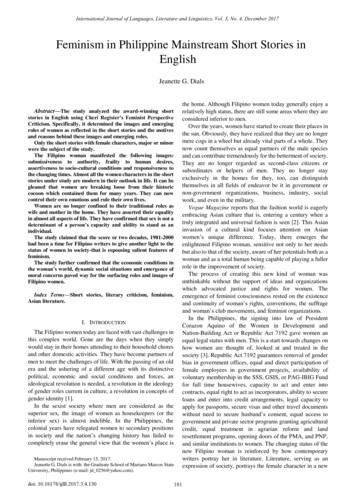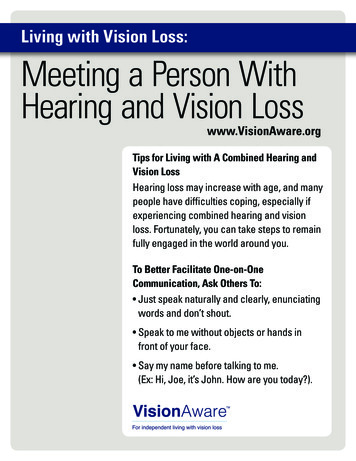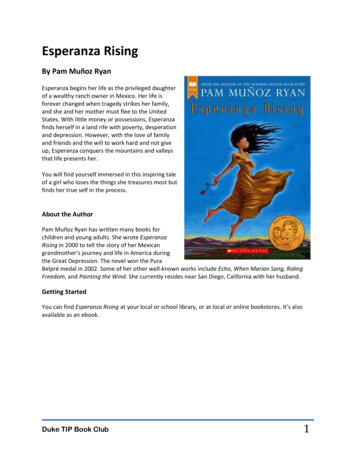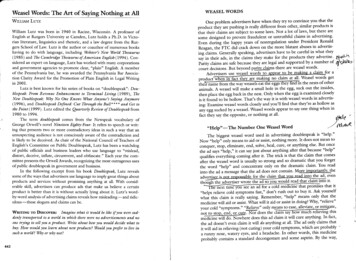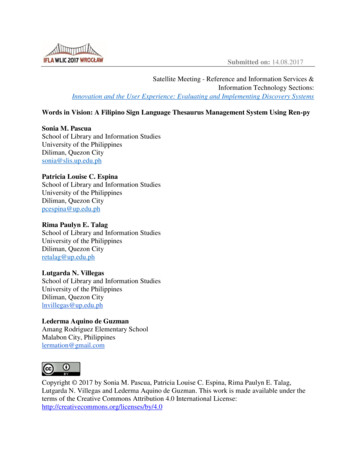
Transcription
Submitted on: 14.08.2017Satellite Meeting - Reference and Information Services &Information Technology Sections:Innovation and the User Experience: Evaluating and Implementing Discovery SystemsWords in Vision: A Filipino Sign Language Thesaurus Management System Using Ren-pySonia M. PascuaSchool of Library and Information StudiesUniversity of the PhilippinesDiliman, Quezon Citysonia@slis.up.edu.phPatricia Louise C. EspinaSchool of Library and Information StudiesUniversity of the PhilippinesDiliman, Quezon Citypcespina@up.edu.phRima Paulyn E. TalagSchool of Library and Information StudiesUniversity of the PhilippinesDiliman, Quezon Cityretalag@up.edu.phLutgarda N. VillegasSchool of Library and Information StudiesUniversity of the PhilippinesDiliman, Quezon Citylnvillegas@up.edu.phLederma Aquino de GuzmanAmang Rodriguez Elementary SchoolMalabon City, Philippineslermation@gmail.comCopyright 2017 by Sonia M. Pascua, Patricia Louise C. Espina, Rima Paulyn E. Talag,Lutgarda N. Villegas and Lederma Aquino de Guzman. This work is made available under theterms of the Creative Commons Attribution 4.0 International License:http://creativecommons.org/licenses/by/4.0
AbstractThe development of technology has been continuously and constantly growing all overthe world, most of which have focused on the improvement of communication. Communication isknown to many as a way of expression either through words or actions. These words and actionsvary in different places and cultures around the globe, but they usually have unique features todistinguish one from the other. However, communication, though it may seem a general featurein society, still has different types: verbal, nonverbal, written and visual. The most commoncommunication type that the majority of the population of the world use in their everyday lives isthrough a combination of verbal communication, that is to be auditory and is oftentimesconveyed through the use of languages uttered by the voice, and nonverbal communicationwhich is delivered through the use of gestures and body language. There are several moremixtures of these communication types that people may use, while on the other hand there aregroups of people who are not able to use more than two of these types.A popular communication channel built solely on gestures is known to many as signlanguage. It is the kind of language that is directly associated with people who are deaf andmute. Findings published in the world health statistics 2015 by the World Health Organizationstate that as of 2015 about 5%, approximately 70 million, of the world’s population being deafand mute only a fraction from this number know how to communicate well using correct signlanguage. Sign language is a universal type of communication that grants mute and deaf peopleto state the exercitation of their intellect. This communication not only limits to people who aredifferently abled but also to people who can use verbal communication but choose also to learnsign language to understand and communicate with people who are deaf and mute.The history of sign language traces back to the 17th century when Juan Pablo Bonnetcreated the first sign language dictionary that also contained the first sign language alphabet.This led to the creation of sign language schools and the development of different kinds of signlanguages around the globe. The most popular form of sign language is the ASL, American SignLanguage, which emerged from the creation of different schools for the deaf in Europe andopened the first of its kind in the United States of America in the early 19th century. At present,there are more than 200 types of sign language around the world. The development is as naturaland continuous as spoken language, which progresses through interaction.The technological advancement of communication at present does not give too muchattention to this nonverbal form of communication. There are still some countries who are justplaced in the position to choose from the current list of sign language types rather than creatingtheir own type of sign language that should represent their own culture and language. The lackof resources in some countries hinder them from creating their own sign language and frombeing educated more about it. The lack of education affects the deficiency of its technologicalprogressions. The Philippines is an example of a country that is still at the starting point of theFSL or Filipino Sign Language which originated from and mostly adapted the ASL. Thedevelopment of the FSL paired with technology may significantly contribute to the knowledge,information and learning of this group in society.The implication of this study is to develop a content management system that desires toshell out facilitation to mute and deaf people in the Philippines. This study will connect andproject the importance of technological development of communication for those who are deaf
and mute. The use of Ren-py, a visual novel engine, will be the platform to create a Filipino SignLanguage thesaurus that can be accessible to its users through different computer devices. Renpy is a widely used platform that enables its users to easily alter script languages to createcertain programs that are very user-friendly. This method is intended to gratify convenience tothe congenital defects of the said group of people. Its design targets to recognize the cornerstoneof having a more straightforward and more manageable application. The ease of access pairedwith learning may hopefully lead to a greater advancement for the education of the deaf andmute. The click of a button may introduce them to better communication with each other.Keywords: Sign language, Ren-py, Filipino Sign Language, mute and deaf, visual novel engine,sign language thesaurusIntroduction“The most important thing in communication is hearing what isn’t said.” (Peter Drucker)Communication is an essential part of being human; we communicate to learn and to understand.It is most common to link communication with speaking, hearing and listening as it is the mostknown way. However, there are various forms of how an individual can communicate, eitherthrough verbal communication, written communication or nonverbal communication. Among thethree stated forms of communication one that is used by the minority is non-verbalcommunication. This type of communication is often used by people who are differently abled,those who have either or both a disability in hearing and speaking. The creation of a channel fornon-verbal communication is through the use of sign language, defined by the CambridgeDictionary as “the system of hand and body movements representing words.”In a study conducted by the World Health Organization in 2015, about 5% or approximately 70million of the world’s population are deaf and mute and thus these are the people who mainlyuse non-verbal communication. Also, according to the same study by the World HealthOrganization, only a fraction of the total number of the deaf and mute can communicate throughproper sign language. Various types of sign languages were created from nation to nation, but itis the American Sign Language that goes an extra mile to continuously develop and become abasis for the other languages. The creation of sign language in every country is based on theirown dictionary of words, considering their languages, culture and dialects. Michelle Jay explainsin her article,“There are different sign languages used around the world. They have all comeabout because of the necessity for the language, communication, and education of deaf people.Sign language has been created due to a natural process and the fact that it is the natural languagefor the deaf.”. However, the common denominator always falls back to the translation of theirnational language to the American Sign Language as a universal point of understandingthroughout the globe. The creation of each unique sign language is very tedious as there are a lotof considerations to be made; also the incorporation and education of it to the concernedcommunity is another factor to consider. Hence, there are not that many official sign languagesaround the world.The Philippines is an archipelago built on different languages arising from about 81 provincesaround the country. Having just one national language, which is Filipino, alongside more than a
100 more languages and dialects across the country, makes this a broader platform in creatingand strengthening Filipino Sign Language. For this study, the researchers have chosen to focuson the national language of the Filipinos which is used and understood by more than half of itstotal population. As of the year 2009, a total of about 517,000 people are part of the deaf andmute community in the Philippines. The same setting in the international scene, discussed in theprevious paragraphs, also apply in the Philippines. The deaf and mute communities more oftenthan not lack education in the proper use of sign language. Looking into this specific communityin the Philippines, the researchers came to find that the absence of proper training and knowledgeon sign language results to individuals creating their own signs to communicate with theirfamily. They exclaimed that the creation of their own sign language results from these factors:(1) illiteracy of both individuals with disabilities and their families, (2) lack of education andsupport, (3) poverty and all the problems that fall under this factor. As for those individuals whoare able to overcome the factors mentioned above, they are educated with the most popular typeof sign language, which is again the American Sign Language.The involvement of the government with Filipino Sign Language is engaged through House Bill6428, which proposes to declare Filipino Sign Language as the National sign language of thedeaf and mute community in the Philippines. It passed its second reading in the Congress lastMarch 2016. Representative Antonio L. Tinio stated in a 2016 interview published on thePhilippine Congress official website, “The FSL, a natural sign language indigenous to theFilipino deaf community, has its own grammar and linguistic structure. FSL is learned withouteffort from interactions of Filipino deaf children with other deaf children and the deafcommunity”.The situation of deaf and mute people in the Philippines presented above became the motivationof the researchers to be pioneers in developing a Filipino Sign Language Thesaurus using anonline application as a platform that could help these people learn and better understand the signlanguage. A thesaurus is defined as “A book of synonyms and near-synonyms in a writtenlanguage, usually arranged conceptually, although dictionary arrangement is not uncommon.”(Reitz, 2004). Though it would be tremendous to be able to create a Filipino Sign Language, it isindeed very difficult and laborious. As a starting point, the creation of a Filipino Sign Languagethesaurus may be a great start for further development of it in the future.However, this does not solely focus on people who are deaf and mute. Researchers believe thatfor one to learn a certain thing, one must teach him or her. In this case, this study also aims toteach the people who are part of the environment of the deaf and mute community, highlightingtheir parents or people who are in their household. Education begins at home and the continuoussupport of the household can play a big role in the development of an individual. People who arealso interested in learning sign language may also benefit greatly from this study.MotivationOne of the skill of a librarian is to create thesauri and this study creates an avenue for librariansto share skill and knowledge with the community. We created a sign language thesaurus in thisstudy and made it available in an application providing easy facility to mute and deaf people inthe Philippines. Our study also connects and projects the importance of technological
development in communication for the society of the deaf and mute, who are sometimesmarginalized in terms of technology provisioning. The platform that our study uses furtherfocuses on the creation of the Filipino Sign Language thesaurus that can be accessible to its usersthrough different computer devices reaching the Filipino community. We wish to alleviate thecongenital defects of the deaf and mute people through the application that this study built. Theease of access paired with learning may hopefully lead to a greater advancement for theeducation of the students who are deaf and mute and the click of a button may introduce them tobetter communication with each other.Background of the StudyCognitive Conditions of Deaf and Mute PeoplePeople who are completely deaf are not capable and will never be adequate to fully comprehendspoken language (Hiskey, 2010). It is difficult for their brains to penetrate spoken language, thatis why sign language is the most appropriate instrument that will cater to their needs. As it isexplained, it is nearly not possible for the deaf to obtain an “inner voice” which allows the brainto acquire and comprehend information. This is in connection with the study that the researchersmust know how people who overcame their disability and learned sign language, specificallythose who built their own vocabulary in their younger years, cognitively processed by relatingthe sign languages with the things they just see. Which in turn in their older years, they learnhow to speak out the words they formed through sign language. One example is the child of Mrs.de Guzman, a co-author, who can speak out words she learned using the help of the signlanguages she acquired. Learning sign language is one thing, but learning how to speak thewords you learned through sign language is another thing. Not everyone who knows how to usesign language can also speak the words they know.The article written by Adams, C., & Malvern, C. (2003), depicted that deaf people recognize theperception of sign language regardless of the language spoken in the country. There are certainlydifferent methods of communicating including through verbal or body language. On the otherhand, signs and symbols can be gained by personal exertion without any difficulties whichanyone can learn as a child, especially the deaf and the mute. With regard to the those who arecapable of hearing, it is more difficult for them to perceive what deaf people do as their brainsperceive divergently (Adams & Malvern, 2003). So, in another way, gestures are significantwhen processing information. It is also mentioned in the article that what deaf people widelyused is the American Sign Language, also known as Ameslan or Sign.Sign language in the PhilippinesIn a 2010 study by Maria Veronica Templo Perez, it is demonstrated how De La Salle-College ofSaint Benilde offered services to deaf people. Deaf people are able to obtain equal educationwith high quality through the usage of Filipino Sign Language. As it has been mentioned above,access of deaf and mute people to learning sign language is often limited. Thus, most of them
cannot proceed with their studies because the services for people with disabilities are not widelyavailable. This study specifically aims to help deaf and mute people, especially those who arepart of the marginalized sector who have limited or no access at all to education in general, toprovide them an application that they can freely and easily access.Although FSL has been challenged to be declared as the national sign language of the FilipinoDeaf and the official language to be used in all government transactions, positions and supportersare not stopping to push for the Filipino Sign Language Law. This bill includes a provision to useFSL as medium of instruction in Deaf Education. This is because Philippine Department ofEducation (DepED) is using American Sign Language and Sign Exact English in schools. Thelaw aims for the shift from ASL to FSL and provisions the needed retraining and retooling ofteachers as well as redeveloping the curriculum and instructional materials.Teaching and Learning sign languageMckee, D., & Woodward, J. (2014) wrote a book where it is explained that teachers should havemore in depth programs and trainings in regard to their sign language teachings. Two programsare established to be able to reach the targets: the Asia-Pacific sign linguistics and the Certificatein Deaf Studies: Teaching New Zealand sign language. These programs aim to provide highereducation for For the communities, or the people who teach them. This book explains thatthorough and continuous learning and development is necessary in teaching sign language. Mrs.de Guzman, on of the co-authors, has undergone a lot of trainings and seminars to fully grasphow sign language works and how it should be taught to other people, specifically those whohave disabilities.Scope and LimitationsFrom the less than a million deaf and mute Filipinos, the researchers have chosen to focus on agroup of deaf and mute students from Amang Rodriguez Elementary School of Malabon City.This was chosen directly by Mrs. Lederma de Guzman, a co-author and Special EducationTeacher in the said School, Malabon III. Mrs. de Guzman has been devoted to learning about andteaching children with hearing impairments as too she is a mother to a child who is part of thiscommunity.In 2007, Mrs. de Guzman was offered a scholarship for “2007 Summer Training Programs forTeachers of Children with Hearing Impairment, Mental Retardation and Learning Disability” bythe Department of Education in the Philippines. This paved the way for the Amang RodriguezElementary School to offer education to children with special needs. Daily classes have beenconducted by Mrs. de Guzman alongside one-on-one sessions for children with multipledisabilities. After a decade, the school has successfully had 5 elementary graduates and 5 moreare now attending regular classes with supervision. And at present, the school has 21 pupilsenrolled with different hearing impairments who are taught in one class.
For this study, a total of 11 students were taught and given the chance to use the Filipino SignLanguage Thesaurus application made by the researchers. Each participant had signed consentsfrom their parents and/or guardians to participate in this study. The confidentiality of theirindividual identities are stated in the waiver given on the Usability Testing (see Appendix A).These participants have different hearing disabilities, a mixture of either severe or profoundhearing loss. They are ages between 6-20 years old but have different cognitive developmentswhich are usually lower than their physical age. It is explained by Mrs. de Guzman, a co-authorwho has been a Special Education teacher since 2007, that hearing impairments have a greatimpact on the cognitive development of each child (Lange & Thompson 2006). The lack as wellof education and literacy play a great role in the delay of learning.The ChallengeLearning sign language is not an easy process. It takes a lot of time and effort to fully understandhow sign language works in communicating with other people. This effort should start within themembers of the household of the individual who is deaf or mute. This exhibited a challenge forthe researchers in reaching out and explaining this importance to the concerned family members.Researchers found out through Mrs. de Guzman, that this is indeed a big challenge because ofthe level of illiteracy within the household itself.This is in connection with another challenge - poverty. In this case, some of the participants ofthe study are part of the marginalized sector of the community who do not have much means tofully give attention to both health and education. Thus they tend to depend on the servicesprovided within their specific municipality which usually does not fully cover the necessities of aperson who has hearing impairments. The delay in medical attention makes it more difficult forthe individual to cope with learning that may or may not be provided to him/her.Another challenge for the researchers is the introduction of the Filipino Sign Language as themedium used in the application developed. This became a challenge because most of the studentswho participated in the study are exposed in the American Sign Language and it is rare for themto use the Filipino Sign Language inside their classrooms. Thus, it will take some time for theparticipants to cope and adapt to the new language medium that is introduced in the application.Below is the framework that exhibits the initial status of language learning for the deaf and mutecommunity in the Philippines. It demonstrates the difficulties of the students who are deaf andmute encounter considering the factors that prevent them from attaining the end product oflearning correct sign language.
Creation of ownsign languagevocabulary bythe deafInterpreter(Immediatefamily and/orteacher) studiesthe unique signlanguage createdby the deafTranslation,Relation andEducationusingAmerican SignLanguageFigure 1. Present initial process of learning sign language by the students who are deaf and muteAt an early age, students who are deaf and mute are forced to develop their own vocabulary to beable to communicate. Aggravating the circumstances when immediate family has not recognizedthe disability early and leads to untoward incidents causing behavioral problems (Lange &Thompson, 2006) to the students who are deaf and mute. Nonetheless, their own sign language iswhat these students who are deaf and mute students have to express themselves and beunderstood. Upon recognition of the impairment, which in most families happens very late(Davis & Carr, 2014), family household start to study the individual sign language created by thedeaf. In a few fortunate cases, an interpreter may bridge the sign language to ASL translation.The predicament faced by the deaf who are taught ASL is when they try to practice it and applyin their household. Some are illiterate so reading is not even a platform to exchanges of learnedwords. Learning a foreign word is seldom another block in the communication.Figure 1 is the conceptual framework of this study. It shows the direct translation andunderstanding of words from individual sign language to the Filipino Sign Language. In thisprocess, the individual sign language words are translated and understood by the deaf in Filipinowhich the household understands. In this way, the continuity of the learning is observed withouthaving to teach the individual the ASL.Creation ofown signlanguagevocabulary bythe deafInterpreter(Immediatefamily and/orteacher) studiesthe unique signlanguageTranslation,Relation andEducation usingthe Filipino SignLanguageThesaurusFigure 2. Process of learning the sign language in the Philippines using the FSL Thesaurus
MethodologyThesaurus ConstructionThesaurus is define as the vocabulary of a controlled indexing language, formally organized sothat the a-priori relationships between concepts are made explicit (Aitchison & Clarke, 2004).For diverse vocabulary of language interpreting from one to another, collation of variousmeanings of words, and to build contextual relationship among words, a thesaurus is a necessity.In addition, Filipino is multilingual and multi-dialectical whereas English is predominantlyutilized in speaking and written communication. Subsequently, ASL is the only sign languageused in the Philippines. It is an existing reference for the deaf and mute community that can beinterpreted and connected through the Filipino Sign Language. The translation of ASL to FSL isthe capability and the power of the thesaurus.This study considers Jessica Milstead’s top-down method - guidelines specifically for use on theAmerican Society for Indexing website. This will serve as the theoretical framework of the studyfor the thesaurus construction. Below are the machinations of the said framework: Convene a group of subject experts to decide on the scope and broad categories of termsto be included. Use existing dictionaries and thesauri to decide on the terms and their relationships. Review and organize the preliminary term set; decide on preferred terms and make useof references from the variants and synonyms; build hierarchical and associativerelationships among the preferred terms. Produce a draft thesauri, conduct recording of videos and usability testing, and revise toobtain final version of thesauri
Figure 3. Filipino Sign Language Thesaurus (FSLT) Application Development FrameworkFSLT Application DevelopmentThis study applied the application development lifecycle through the utilization of the FSLTApplication Development Framework shown in Figure 3. Presented below are the stages of theframework and the steps that this research executed.Stage 1: PlanningA. Identify problem and objectivesInspired by Mackinnon’s (2015) study which created digital Jamaican Sign Language Dictionaryusing a R2D2 approach, the authors longed to create a Filipino Sign Language thesaurus. Furtherinvestigation was done to see if there is an existing FSL. However, the exploration revealed thatat present there is no existing FSL thesaurus. Therefore, authors faced the following challenges: ASL has no Filipino translation for sign languageThe difficulty in learning sign language by the Filipino deaf and mute communityThe prolonged cycle of learning sign languageThesaurus from ASL to FSL is constructed which gradually built the foundation of FSLvocabulary. Researchers aimed to develop an interactive application in learning the FSL.
B. Inventory of resourcesThe interest to create an interactive application was done through the use of a visual novelengine. The ease of development and access paired with the convenience it supplies to the usersmake it the best platform for the chosen participants. Key people involved were identified.C. Formulate and evaluate alternativesVideo recordings were provided and the need for auditory platform was contemplated in order tocater the full potential of the application. Wordings and instructions are supplemented as basicfeatures. Modes of assessment were added to highlight the outcome of learning.D. Draft of the planA series of meetings was conducted to formulate action items, timelines and scope of thedevelopment of the application. Frameworks were designed, alternatives were presented, andapplication development processes were identified.Stage 2: Research DesignA. Action Research DesignThe study used action research design where researchers discovered ways to improve howFilipino communities address issues of being deaf and mute in their communication.B. Thesaurus Construction Framework Convene a group of subject experts to decide on the scope and broad categories of terms to beincluded.Filipino Sign Language professionals in the Philippines were tapped, namely: Ms. Julia LuzMiralles a sign language interpreter of Church of God International; Ma. Joy Enverga ofPhilippine Registry of Interpreters and Ms. Lederman de Guzman a co-author and SpecialEducation (SPED) teacher focusing on deaf and mute students in Amang Rodriguez ElementarySchool Malabon City. Thorough discussion was carried out to define the scope of the thesaurusconstruction and application development. Consultation also took place amongst the educatorsfrom School of Deaf Education and Applied Studies of De La Salle-College of Saint Benilde tofacilitate further comprehension of the issue. Use existing dictionaries and thesauri to decide on the terms and their relationships.The experts were using ASL in their educational instruction. Therefore, vocabularies of ASL arethe existing dictionary used to build words and word relationship in FSLT. Review and organize the preliminary term set: decide on preferred terms and make usereferences from the variants and synonyms; and build hierarchical and associative relationshipsamong the preferred terms.
The use of Filipino Sign Language (FSL) has been a challenge as per Ma’am Lederma. Asidefrom the fact that it is not yet being used, her training is in ASL. She had a lot of attempts intrying to create and develop FSL instructional modules and materials that will aid her in herinstruction and teaching however she had only taken an initial preparation and some manualvideo recordings. She was hoping that in institutionalizing FSL, training and retooling will beprovided by the Philippine Government as well as funds in developing curriculum andinstructional materials.This study developed the thesaurus for FSL which started the classification and taxonomies ofFilipino words. It considered the cognitive age of the students which is of kinder level eventhough their physical age ranges from 6-20 years old. The question of understanding the words inFSL which is taught in ASL is considered in the use of the FSL thesaurus. FSLT formulated theequivalent, associative, and hierarchical relationships of terms and translations in Filipino fromASL that the interpreters knew.The following below are the guide questions this thesaurus construction followed:1. What are the words that can be translated in FSL?2. What existing standards and controlled vocabularies can be used for the translation?3. What are the relationships of the words ( equivalent, associative, and hierarchicalrelationships )?4. Which of the words are going to be included in the terminologies of the FSLTapplication?FSLT application will serve as an interactive tool for reference purposes. It will help invocabulary search for sign language and vice versa - sign language to fingerspell words. Forgreater purpose it supports the House Bill 2049 declaring FSL as the national sign language ofthe Filipino Deaf and the official language to be used in all government transactions. By this, itaspires to strengthen the use of FSL.Figure 4, shows the storyboard that plotted the conce
of sign language, which is again the American Sign Language. The involvement of the government with Filipino Sign Language is engaged through House Bill 6428, which proposes to declare Filipino Sign Language as the National sign language of the deaf and mute community in the Philippines. It p


